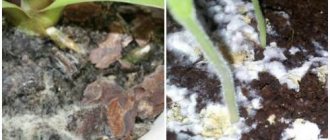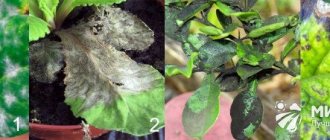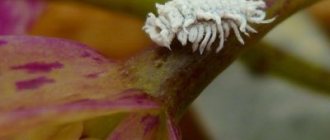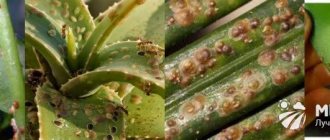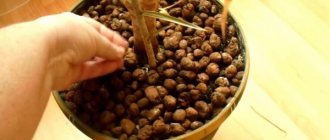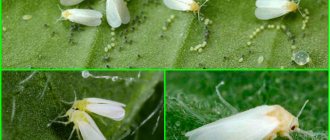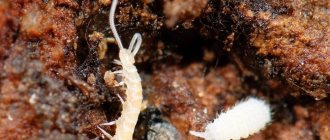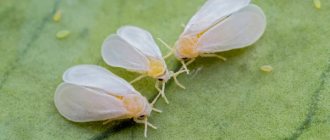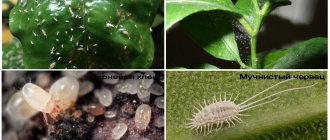Causes and symptoms
White coating on houseplants can be caused by a fungal disease or a pest that can create a white coating on the plant. If you care for your plants properly, pests or diseases will be kept to a minimum. But a situation may arise where diseases and pests can harm your plant.
- - a decrease in temperature below optimal conditions, usually below 10 degrees.
- — excess moisture in the pots or high humidity can cause diseases.
- - excess nutrients. Increasing the permissible norm of nutrients (fertilizers) can contribute to the development of diseases.
- - the reason for the deterioration in appearance may be the fact that the plant becomes cramped in its own pot. In other words, he has outgrown it.
- — violation of the watering regime (severe drying or excessive watering).
- - fungal diseases can be airborne (spores) or may be contained in irrigation water.
Any violation of the conditions for growing indoor plants reduces immunity and opens up the possibility of damage by pests or diseases.
Why is mold dangerous?
Since people are accustomed to treating fungal diseases, it seems quite obvious that they are also dangerous for plants. And here it is worth highlighting several key points.
- Soil deterioration. The quality of a substrate affected by mold is greatly reduced. It disrupts not only water but also mineral metabolism, as well as the acid-base balance, its composition changes and becomes unsuitable for cultivated plants.
- Death of plants. Mold turns the top layer of soil into a crust that is impermeable to air and retains water. Plant roots cannot tolerate excessive moisture and begin to rot, which leads to the death of the plant. Moreover, due to all these negative changes, it does not receive enough nutrients, which is also harmful and leads to death. The same fate may also await the lower branches and leaves and young shoots of flowers.
- Infection of the premises. If you are dealing with black mold, the danger is especially great. It can spread to the window sill, frames, walls and ceiling. And black mold is harmful to the human body, especially when it comes to children, the elderly and people with allergies.
Black mold, following the plants, can affect both the window and the windowsill
Signs of appearance
In order to understand what kind of plaque is on your plant, you need to examine it. A white coating may appear on the leaves - this is generally the first sign of damage to the plant by powdery mildew. Powdery mildew develops well in high humidity.
Powdery mildew is considered a disease of garden plants. But it can also be found on indoor plants.
The spread of this disease to indoor plants can be caused by the soil used for planting. If you worked in the garden, you could have carried it on your clothes or shoes. Ficus trees are especially sensitive to this disease.
But white bloom can also be a sign of pest damage to the plant. On house flowers, a white coating like cotton wool can be caused by mealybugs. This pest also creates a sticky coating on the leaves of indoor plants. It manifests itself differently on different indoor plants.
With any attack by this pest, the plants become covered with a white coating, subsequently the plant becomes covered with a sticky coating, the shoots are bent, growth stops, as this pest sucks out the juice and covers the leaves with a sticky coating. This significantly reduces the ability of any plant to develop and grow fully.
Less commonly, but it is possible, there may be aphids, a large accumulation of these pests can form a plaque on the plant.
Having understood the reason, it is necessary to begin the prevention, treatment and destruction of pests and diseases.
There may also be a white coating on the soil - this is the main sign of a fungal disease, and this occurs due to excessive watering and poor drainage in the pot with the plant.
So, the causes of white plaque on indoor plants can be caused by pests and fungal diseases.
Why do flowers get moldy?
If you have indoor plants in your home or office, you've probably seen a whitish or yellowish coating on the ground or walls of pots and planters. Actually, this is how mold begins to develop - from a barely noticeable coating. Most often, those flowers that suffer from this insidious fungus are those that do not need intensive watering and cannot absorb large amounts of moisture at once. These are, for example, cacti, succulents (among them are aloe, spurge, “money tree” and the very popular “mother-in-law’s tongue”, or sansevieria), so-called “living stones”, as well as violets.
A flower pot affected by mold is a sad sight
There are not as many varieties of mold as there are plants, but several types can still be listed.
- White mold. That same white coating, which can then grow into a fluffy blanket on the ground. This is one of the most common types of mold and almost the safest. At first, by the way, it can be confused with a mineral deposit on the soil, but it feels much softer and thinner to the touch.
White mold, once it appears in a pot, can destroy the plant itself.
- Blue mold. Bluish fungi most often affect wood - that is, indoor trees and decorative wood chips, which many people use to decorate flower pots and wooden flowerpots and plant tubs, are in danger.
- Black mold. The most dangerous type of mold, both for plants and humans, is black mold. It is difficult to notice on the ground, but much easier - on the tray of a pot or on a windowsill. At first glance, black mold can be confused with soil, but this similarity is apparent. Unlike soil, mold is not easy to clean off. If you wipe a contaminated surface, ingrained marks will probably remain there.
Black mold can also spread from the soil to the leaves of the plant.
Whatever the type of mold, all these types are related and the reasons for their appearance are similar.
- Infected substrate. The simplest thing is that perhaps the soil in your pot was already affected by mold even before you put it there. If you dug it up in the yard, then this is not surprising. But if you bought land in a store, then this is a serious reason to think about the integrity of the manufacturer. Or about compliance with storage conditions at the point of sale.
- Excessive watering. As mentioned above, some plants don't need much moisture and you may just want to "flood" them. Flowers do not have time to absorb so much water, their lower leaves and roots begin to rot - all this, combined with high humidity, creates a breeding ground for fungus.
- Wet air. If everything is fine with watering, the problem may be that the air in the room with flowers is too humid. This is justified for a greenhouse with tropical plants, but for most of our house flowers such conditions are not suitable - the plants will wither and mold will grow.
- Poor drainage. Another possible reason is an improperly arranged pot. It must have a drainage hole and a spacious tray for excess water. At the bottom it is worth creating a drainage layer of pebbles or expanded clay. The soil must be structured in a manner suitable for a particular plant - it is best to buy a special substrate formulated for different types of house flowers. Clay soils should be used especially carefully - they retain moisture greatly and can also contribute to the appearance of mold.
Treatment and prevention.
A fungal disease can cause a moldy coating on the plant or soil. If the infection is not severe, it is enough to disinfect the soil. For this, a weak solution of magranz or a special product can help you. Sometimes, if the moldy deposit is only on the surface of the soil, the top layer of soil can be replaced with a new one. In case of severe infection and if disinfection does not help, you will have to completely replace the soil in the pot.
When replacing the soil, you will need to carefully free the plant, try to minimally injure the root system. The plant must be dried for 24 hours, then planted in a new pot and the soil completely replaced. If mold appears on the stem or leaves, try wiping the plant with a damp cloth. If the mold is removed, then the damage is not big. But if mold spots remain, then the infection has already penetrated deep into the plant, you will have to remove all the affected leaves and shoots. Next, we disinfect the soil.
Infection with mealybugs is a rather labor-intensive task. In case of early infection, it is enough to collect the pest with a cotton swab dipped in an alcohol solution. Then the entire plant should be treated with a special preparation. From personal experience I can say that treating the plant with a weak feri solution helps a lot.
After treating the plant (spraying or wiping the leaves), it is better to put it in a plastic bag. When using a detergent or soap solution, the procedure of washing leaves and shoots must be carried out until the pest completely disappears. Of course, the use of appropriate medications will speed up the treatment process.
Gray rot, which also has a white coating, is practically incurable; if the plant is severely damaged, it dies. Most likely the cause of this disease is poor care.
Powdery mildew - here you need to understand what kind of powdery mildew it is. Since it could also be downy mildew. In the early stages of infection, a manganese solution copes well with the problem. Which should be sprayed on plants. In case of severe infection, we use appropriate medications.
As a preventive measure and to avoid infection with white plaque, a number of measures should be followed that will allow you to avoid infection and the appearance of pests and diseases.
- — we update the soil in the pot; if the root system is well developed, then it is enough to update the top layer of soil.
- - of course, control over watering, it should not be too frequent, and also not allow the earthen clod to dry out. You should also take care of good drainage.
- — every season, when plants are more active in growth and development (spring-summer), we carry out preventive spraying with appropriate preparations.
pest control products
To prevent your indoor plants from becoming infected or affected by pests and diseases. Try to follow all the rules for growing indoor plants. We pay special attention to the soil or soil. If you create the soil mixture yourself, it should be disinfected. It is advisable to treat all soil mixtures with appropriate preparations; if this mixture includes sand, it can be calcined in the oven. The ready-made soil mixture sold in stores is not always good. It may even contain pest larvae or fungal spores. It is advisable to treat it also for prevention.
When planting, use drainage, as well as vermiculite or perlite, which we add to the soil, it loosens the soil. Good drainage will allow excess moisture to escape into the pan. Stagnant moisture and constantly damp soil are good conditions for the development of fungal diseases and all kinds of rot. We pay attention to watering. It must be timely and take into account the requirements of the plant. Excessive watering or drying out the earthen coma contributes to a decrease in its own protective qualities and the formation of problems. Good luck to you.
Preventive measures
The well-known rule - a disease is easier to prevent than to cure - applies to all living things, including indoor flowers. In order not to miss the moment of infection, it is enough to follow simple measures:
- regular inspections of plants for stains and pests
- cleaning leaves from dust
- pruning, removing old leaves in contact with the ground
- creating optimal conditions for each species, taking into account lighting, humidity, temperature and feeding
The gardener's constant attention to his pets, his compliance with agricultural technology and living conditions, as well as first aid if necessary - these are the main components of the health and well-groomed appearance of indoor plants.
Video about ways to combat powdery mildew:
What is a mealybug?
Characteristics of a harmful insect:
- the size of the parasite is modest - from 3 to 6 mm;
- the soft-bodied insect has no wings, the adult moves rather slowly;
- the body is covered with a powdery coating of dull white color, preventing moisture loss;
- clusters of parasites resemble dirty cotton wool stuck to the leaves;
- Most often, pests are located in groups on a plant;
- A characteristic feature of the structure is a long proboscis. Using their mouthparts, parasites actively suck juices from flowers and prefer to feed in the area of buds and young leaves. Some species parasitize roots or fruits, extracting nutrients from these zones;
- Not only adult males and females are dangerous for the plant, but also young individuals that actively move around various parts in search of food.
Plaque of black, red and other colors
Over my almost 20 years of floriculture experience, I have seen different types of plaque. For example, red spots on hibiscus and pelargonium, which turned out to be a disease known as rust - a mycosis caused by parasitic fungi. It looks like this: an orange, yellow or brown coating appears on the underside of the leaf, and soon the damaged part of the plant dries out.
The cause of the disease is dampness in the room at low air temperatures, from 10 to 20°C. Damaged leaves need to be removed, and the plant must be at least temporarily given a “hot climate.” I temporarily covered my hibiscus with a transparent bag and placed it in a warm place - near the heater. When the temperature under the hood reaches 30 degrees, the fungi will stop actively multiplying, but to cure the plant, you need to spray it several times with special fungicides (once a week for a month).
You cannot spray with regular water at this time - spores ripen in the droplets on the leaves.
- Why flowers get sick: symptoms and causes
Another type of disease is black plaque on the leaves . It is caused by black sooty fungi, or mobs, as they are often called. They love to settle in sticky traces of the activity of parasitic insects (thrips, aphids, scale insects). Citrus fruits, azaleas, camellias and palm trees most often suffer from black plaque.
The leaf of a diseased plant appears as if covered with black powder or dark crust. This disfigures the plant, prevents it from breathing and inhibits the process of photosynthesis.
Flower growers advise fighting insects that leave a sweet coating in which fungi settle, and you can improve the appearance of the plant by washing it well in the shower, carefully cleaning each leaf with a sponge. I don’t have plants that are susceptible to black bloom disease, and although any flower can get sick under favorable conditions for fungi, I’m glad that I was lucky enough to avoid this trouble.
How to get rid of mold in flower pots
The fight against a dangerous fungus can be carried out in different ways, each of which is effective in its own way.
Mechanical method of fighting
The mechanical method involves removing the top contaminated layer of soil and adding new clean soil in its place. If the fungal infection is very strong, then the easiest way is to transplant the plant into a new pot using a clean substrate.
After replanting, it is very important to regularly loosen the soil and water the plant properly. A new portion of water must be added to the pot only after the top layer of soil has completely dried.
Use of beneficial bacteria and bactericidal components
Adding special components that have bactericidal properties to the soil will help get rid of the fungus. Gardeners consider the most effective to use sphagnum moss and charcoal .
Also in the fight against mold, the drug Fitosporin . It contains special beneficial bacteria that prevent the appearance of rot and fungi.
Using citric acid against mold
A fairly popular method of combating mold is the use of citric acid. To do this, when watering plants, add a small amount of lemon juice or citric acid to the water. This solution has a beneficial effect on the plant and is detrimental to the fungus.
Prevention is easier than cure
Fixing a problem is always more difficult than preventing it. Following simple rules saves time and allows you to grow indoor flowers healthy and beautiful.
- Do not water flowers with tap water. It needs to be defended, and for prevention it is sometimes recommended to soften it with citric acid.
- Do not overfill and watch the drainage holes so that they do not become clogged.
- Keep the container with the plant away from heating devices, spray and humidify the air in the room more often.
- The volume of the pot should be selected according to the size of the flower.
- To prevent fungal diseases, activated carbon is used once a month. A good disinfectant is a weak solution of potassium permanganate, which can be used for irrigation instead of ordinary water.
- In winter, fertilizing with fertilizers should be stopped, and loosening the soil will only be beneficial.
